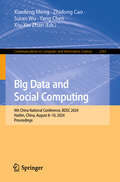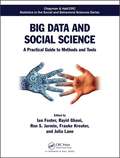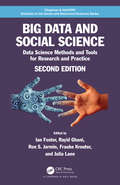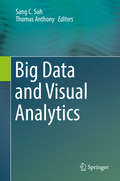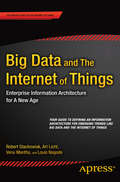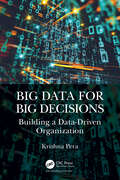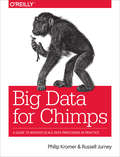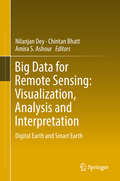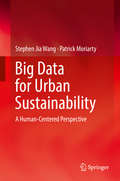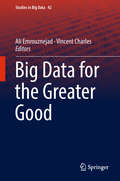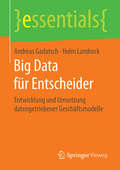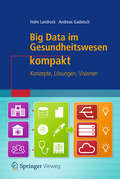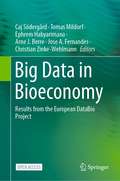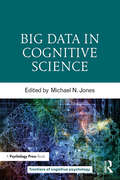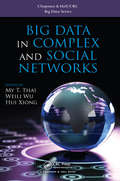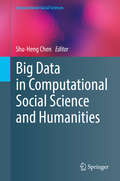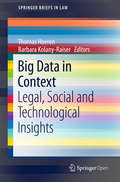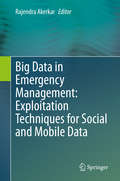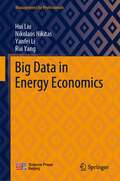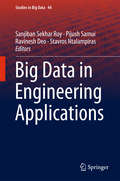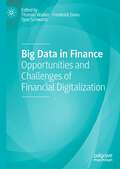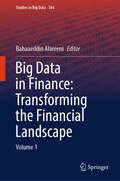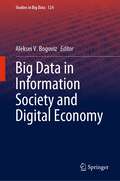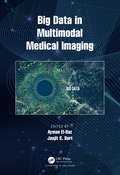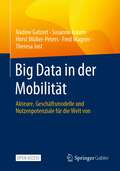- Table View
- List View
Big Data and Social Computing: 9th China National Conference, BDSC 2024, Harbin, China, August 8–10, 2024, Proceedings (Communications in Computer and Information Science #2161)
by Xiaofeng Meng Yang Chen Zhidong Cao Suran Wu Xiu-Xiu ZhanThis book constitutes the refereed proceedings of the 9th China National Conference on Big Data and Social Computing, BDSC 2024, held in Harbin, China, during August 8–10, 2024. The 28 full papers presented in this volume were carefully reviewed and selected from a total of 141 submissions. The papers in the volume are organized according to the following topics: digital society and public security; modelling and simulation of social systems; internet intelligent algorithm governance; social network and group behavior; innovation, risks, and network security of large language models; and artificial intelligence and cognitive science.
Big Data and Social Science: A Practical Guide to Methods and Tools
by Frauke Kreuter Julia Lane Ian Foster Rayid Ghani Ron S. JarminBig Data and Social Science: A Practical Guide to Methods and Tools shows how to apply data science to real-world problems in both research and the practice. The book provides practical guidance on combining methods and tools from computer science, statistics, and social science. This concrete approach is illustrated throughout using an important national problem, the quantitative study of innovation. The text draws on the expertise of prominent leaders in statistics, the social sciences, data science, and computer science to teach students how to use modern social science research principles as well as the best analytical and computational tools. It uses a real-world challenge to introduce how these tools are used to identify and capture appropriate data, apply data science models and tools to that data, and recognize and respond to data errors and limitations.
Big Data and Social Science: Data Science Methods and Tools for Research and Practice (Chapman & Hall/CRC Statistics in the Social and Behavioral Sciences)
by Ian Foster, Rayid Ghani, Ron S. Jarmin, Frauke Kreuter and Julia LaneBig Data and Social Science: Data Science Methods and Tools for Research and Practice, Second Edition shows how to apply data science to real-world problems, covering all stages of a data-intensive social science or policy project. Prominent leaders in the social sciences, statistics, and computer science as well as the field of data science provide a unique perspective on how to apply modern social science research principles and current analytical and computational tools. The text teaches you how to identify and collect appropriate data, apply data science methods and tools to the data, and recognize and respond to data errors, biases, and limitations. Features: Takes an accessible, hands-on approach to handling new types of data in the social sciences Presents the key data science tools in a non-intimidating way to both social and data scientists while keeping the focus on research questions and purposes Illustrates social science and data science principles through real-world problems Links computer science concepts to practical social science research Promotes good scientific practice Provides freely available workbooks with data, code, and practical programming exercises, through Binder and GitHub New to the Second Edition: Increased use of examples from different areas of social sciences New chapter on dealing with Bias and Fairness in Machine Learning models Expanded chapters focusing on Machine Learning and Text Analysis Revamped hands-on Jupyter notebooks to reinforce concepts covered in each chapter This classroom-tested book fills a major gap in graduate- and professional-level data science and social science education. It can be used to train a new generation of social data scientists to tackle real-world problems and improve the skills and competencies of applied social scientists and public policy practitioners. It empowers you to use the massive and rapidly growing amounts of available data to interpret economic and social activities in a scientific and rigorous manner.
Big Data and Visual Analytics
by Sang C. Suh Thomas AnthonyThis book provides users with cutting edge methods and technologies in the area of big data and visual analytics, as well as an insight to the big data and data analytics research conducted by world-renowned researchers in this field. The authors present comprehensive educational resources on big data and visual analytics covering state-of-the art techniques on data analytics, data and information visualization, and visual analytics. Each chapter covers specific topics related to big data and data analytics as virtual data machine, security of big data, big data applications, high performance computing cluster, and big data implementation techniques. Every chapter includes a description of an unique contribution to the area of big data and visual analytics. This book is a valuable resource for researchers and professionals working in the area of big data, data analytics, and information visualization. Advanced-level students studying computer science will also find this book helpful as a secondary textbook or reference.
Big Data and the Internet of Things: Enterprise Information Architecture for A New Age
by Robert Stackowiak Art Licht Venu Mantha Louis NagodeEnterprise Information Architecture for a New Age: Big Data and The Internet of Things, provides guidance in designing an information architecture to accommodate increasingly large amounts of data, massively large amounts of data, not only from traditional sources, but also from novel sources such everyday objects that are fast becoming wired into global Internet. No business can afford to be caught out by missing the value to be mined from the increasingly large amounts of available data generated by everyday devices. The text provides background as to how analytical solutions and enterprise architecture methodologies and concepts have evolved (including the roles of data warehouses, business intelligence tools, predictive analytics, data discovery, Big Data, and the impact of the Internet of Things). Then you're taken through a series of steps by which to define a future state architecture and create a plan for how to reach that future state. Enterprise Information Architecture for a New Age: Big Data and The Internet of Things helps you gain an understanding of the following: Implications of Big Data from a variety of new data sources (including data from sensors that are part of the Internet of Things) upon an information architecture How establishing a vision for data usage by defining a roadmap that aligns IT with line-of-business needs is a key early step The importance and details of taking a step-by-step approach when dealing with shifting business challenges and changing technology capabilities How to mitigate risk when evaluating existing infrastructure and designing and deploying new infrastructure Enterprise Information Architecture for a New Age: Big Data and The Internet of Things combines practical advice with technical considerations. Author Robert Stackowiak and his team are recognized worldwide for their expertise in large data solutions, including analytics. Don't miss your chance to read this book and gain the benefit of their advice as you look forward in thinking through your own choices and designing your own architecture to accommodate the burgeoning explosion in data that can be analyzed and converted into valuable information to drive your business forward toward success. What you'll learn Grasp the big picture of the trend toward enterprise analytic solutions Define and validate a vision for a future state within your organization Ensure that your vision is aligned with line-of-business needs Understand available skills and align your IT infrastructure to the new vision Address Data Governance, Security, Data Quality, and other important attributes Implement the new vision while dealing successfully with changes in scope Who this book is for Enterprise Information Architecture for a New Age: Big Data and The Internet of Things for a New Age is most targeted at Enterprise Architects in an organization (commercial company, public sector agency, systems integrator), but will also appeal to IT managers, CIOs, line-of-business IT executives, and others seeking to understand how to define enterprise analytics architectures and justify projects that are focused in this area. Table of Contents Introduction Chapter 1. Big Data Solutions and Internet of Things Chapter 2. Evaluating the Art of the Possible Chapter 3. Business Drivers behind Big Data and Internet of Things Chapter 4. Business Information Mapping Chapter 5. Skills for Big Data and Internet of Things Chapter 6. Architecture for Big Data and Internet of Things Chapter 7. Planning Big Data and Internet of Things Projects Chapter 8. Big Data and Internet of Things Implementation Chapter 9. Appendix A Chapter 10. Appendix B
Big Data for Big Decisions: Building a Data-Driven Organization
by Krishna PeraBuilding a data-driven organization (DDO) is an enterprise-wide initiative that may consume and lock up resources for the long term. Understandably, any organization considering such an initiative would insist on a roadmap and business case to be prepared and evaluated prior to approval. This book presents a step-by-step methodology in order to create a roadmap and business case, and provides a narration of the constraints and experiences of managers who have attempted the setting up of DDOs. The emphasis is on the big decisions – the key decisions that influence 90% of business outcomes – starting from decision first and reengineering the data to the decisions process-chain and data governance, so as to ensure the right data are available at the right time, every time. Investing in artificial intelligence and data-driven decision making are now being considered a survival necessity for organizations to stay competitive. While every enterprise aspires to become 100% data-driven and every Chief Information Officer (CIO) has a budget, Gartner estimates over 80% of all analytics projects fail to deliver intended value. Most CIOs think a data-driven organization is a distant dream, especially while they are still struggling to explain the value from analytics. They know a few isolated successes, or a one-time leveraging of big data for decision making does not make an organization data-driven. As of now, there is no precise definition for data-driven organization or what qualifies an organization to call itself data-driven. Given the hype in the market for big data, analytics and AI, every CIO has a budget for analytics, but very little clarity on where to begin or how to choose and prioritize the analytics projects. Most end up investing in a visualization platform like Tableau or QlikView, which in essence is an improved version of their BI dashboard that the organization had invested into not too long ago. The most important stakeholders, the decision-makers, are rarely kept in the loop while choosing analytics projects. This book provides a fail-safe methodology for assured success in deriving intended value from investments into analytics. It is a practitioners’ handbook for creating a step-by-step transformational roadmap prioritizing the big data for the big decisions, the 10% of decisions that influence 90% of business outcomes, and delivering material improvements in the quality of decisions, as well as measurable value from analytics investments. The acid test for a data-driven organization is when all the big decisions, especially top-level strategic decisions, are taken based on data and not on the collective gut feeling of the decision makers in the organization.
Big Data for Chimps: A Guide to Massive-Scale Data Processing in Practice
by Russell Jurney Philip Flip KromerFinding patterns in massive event streams can be difficult, but learning how to find them doesn’t have to be. This unique hands-on guide shows you how to solve this and many other problems in large-scale data processing with simple, fun, and elegant tools that leverage Apache Hadoop. You’ll gain a practical, actionable view of big data by working with real data and real problems.Perfect for beginners, this book’s approach will also appeal to experienced practitioners who want to brush up on their skills. Part I explains how Hadoop and MapReduce work, while Part II covers many analytic patterns you can use to process any data. As you work through several exercises, you’ll also learn how to use Apache Pig to process data.Learn the necessary mechanics of working with Hadoop, including how data and computation move around the clusterDive into map/reduce mechanics and build your first map/reduce job in PythonUnderstand how to run chains of map/reduce jobs in the form of Pig scriptsUse a real-world dataset—baseball performance statistics—throughout the bookWork with examples of several analytic patterns, and learn when and where you might use them
Big Data for Remote Sensing: Digital Earth And Smart Earth
by Nilanjan Dey Chintan Bhatt Amira S. AshourThis book thoroughly covers the remote sensing visualization and analysis techniques based on computational imaging and vision in Earth science. Remote sensing is considered a significant information source for monitoring and mapping natural and man-made land through the development of sensor resolutions that committed different Earth observation platforms. The book includes related topics for the different systems, models, and approaches used in the visualization of remote sensing images. It offers flexible and sophisticated solutions for removing uncertainty from the satellite data. It introduces real time big data analytics to derive intelligence systems in enterprise earth science applications. Furthermore, the book integrates statistical concepts with computer-based geographic information systems (GIS). It focuses on image processing techniques for observing data together with uncertainty information raised by spectral, spatial, and positional accuracy of GPS data. The book addresses several advanced improvement models to guide the engineers in developing different remote sensing visualization and analysis schemes. Highlights on the advanced improvement models of the supervised/unsupervised classification algorithms, support vector machines, artificial neural networks, fuzzy logic, decision-making algorithms, and Time Series Model and Forecasting are addressed. This book guides engineers, designers, and researchers to exploit the intrinsic design remote sensing systems. The book gathers remarkable material from an international experts' panel to guide the readers during the development of earth big data analytics and their challenges.
Big Data for Urban Sustainability
by Stephen Jia Wang Patrick MoriartyThis book presents a practical framework for the application of big data, cloud, and pervasive and complex systems to sustainable solutions for urban environmental challenges. It covers the technologies, potential, and possible and impact of big data on energy efficiency and the urban environment.The book first introduces key aspects of big data, cloud services, pervasive computing, and mobile technologies from a pragmatic design perspective, including sample open source firmware. Cloud services, mobile and embedded platforms, interfaces, operating system design methods, networking, and middleware are all considered. The authors then explore in detail the framework, design principles, architecture and key components of developing energy systems to support sustainable urban environments. The included case study provides a pathway to improve the eco-efficiency of urban transport, demonstrating how to design an energy efficient next generation urban navigation system by leveraging vast cloud data sets on user-behavior. Ultimately, this resource maps big data’s pivotal intersection with rapid global urbanization along the path to a sustainable future.
Big Data for the Greater Good (Studies in Big Data #42)
by Ali Emrouznejad Vincent CharlesThis book highlights some of the most fascinating current uses, thought-provoking changes, and biggest challenges that Big Data means for our society. The explosive growth of data and advances in Big Data analytics have created a new frontier for innovation, competition, productivity, and well-being in almost every sector of our society, as well as a source of immense economic and societal value. From the derivation of customer feedback-based insights to fraud detection and preserving privacy; better medical treatments; agriculture and food management; and establishing low-voltage networks – many innovations for the greater good can stem from Big Data. Given the insights it provides, this book will be of interest to both researchers in the field of Big Data, and practitioners from various fields who intend to apply Big Data technologies to improve their strategic and operational decision-making processes.
Big Data für Entscheider: Entwicklung und Umsetzung datengetriebener Geschäftsmodelle (essentials)
by Andreas Gadatsch Holm LandrockAndreas Gadatsch und Holm Landrock zeigen an typischen Beispielen aus der Praxis, wie datengetriebene Geschäftsmodelle entstehen. Sie erläutern, wie sich Big-Data-Projekte rechnen und wie man am einfachsten an die Analyse großer Datenmengen herangeht. Eine Bewertung der zentralen Aspekte von Projekten und der dort eingesetzten Technologien erleichtert den Lesern die tägliche Praxis im IT-Management. Die Autoren stellen Hadoop als eine der wichtigen Big-Data-Technologien vor.
Big Data im Gesundheitswesen kompakt: Konzepte, Lösungen, Visionen (It Kompakt Ser.)
by Andreas Gadatsch Holm LandrockDas kompakte Fachbuch gibt einen Überblick über die Möglichkeiten von „Big Data“ im Gesundheitswesen und beschreibt anhand von ausgewählten Szenarien mögliche Einsatzgebiete.Die Autoren erläutern zentrale Systemkomponenten und IT-Standards und thematisieren anhand wichtiger Daten des Gesundheitswesens die Notwendigkeit der Strukturierung und Modellierung von Daten. Das Buch gibt Hinweise wie Geschäftsprozesse im Gesundheitswesen dokumentiert, analysiert und verbessert werden können. Anwendungsszenarien, wie die Datenanalysen für Krankenhäuser, Labore, Versicherungen und die Pharmaindustrie, zeigen die praktische Relevanz des Themas. Aber auch rechtliche und ethische Aspekte werden inhaltlich angeschnitten.Ein Buch für Entscheider in der medizinischen Leitung und Verwaltung von Krankenhäusern, Fachleute sowie niedergelassene Ärzte und Apotheker, aber auch Personen in Ausbildung und Studium im Gesundheitswesen.
Big Data in Bioeconomy: Results from the European DataBio Project
by Christian Zinke-Wehlmann Caj Södergård Tomas Mildorf Ephrem Habyarimana Arne J. Berre Jose A. FernandesThis edited open access book presents the comprehensive outcome of The European DataBio Project, which examined new data-driven methods to shape a bioeconomy. These methods are used to develop new and sustainable ways to use forest, farm and fishery resources. As a European initiative, the goal is to use these new findings to support decision-makers and producers – meaning farmers, land and forest owners and fishermen.With their 27 pilot projects from 17 countries, the authors examine important sectors and highlight examples where modern data-driven methods were used to increase sustainability. How can farmers, foresters or fishermen use these insights in their daily lives? The authors answer this and other questions for our readers. The first four parts of this book give an overview of the big data technologies relevant for optimal raw material gathering. The next three parts put these technologies into perspective, by showing useable applications from farming, forestry and fishery. The final part of this book gives a summary and a view on the future.With its broad outlook and variety of topics, this book is an enrichment for students and scientists in bioeconomy, biodiversity and renewable resources.
Big Data in Cognitive Science (Frontiers of Cognitive Psychology)
by Michael N. JonesWhile laboratory research is the backbone of collecting experimental data in cognitive science, a rapidly increasing amount of research is now capitalizing on large-scale and real-world digital data. Each piece of data is a trace of human behavior and offers us a potential clue to understanding basic cognitive principles. However, we have to be able to put the pieces together in a reasonable way, which necessitates both advances in our theoretical models and development of new methodological techniques. The primary goal of this volume is to present cutting-edge examples of mining large-scale and naturalistic data to discover important principles of cognition and evaluate theories that would not be possible without such a scale. This book also has a mission to stimulate cognitive scientists to consider new ways to harness big data in order to enhance our understanding of fundamental cognitive processes. Finally, this book aims to warn of the potential pitfalls of using, or being over-reliant on, big data and to show how big data can work alongside traditional, rigorously gathered experimental data rather than simply supersede it. In sum, this groundbreaking volume presents cognitive scientists and those in related fields with an exciting, detailed, stimulating, and realistic introduction to big data – and to show how it may greatly advance our understanding of the principles of human memory, perception, categorization, decision-making, language, problem-solving, and representation.
Big Data in Complex and Social Networks (Chapman & Hall/CRC Big Data Series)
by My T. Thai, Weili Wu, Hui XiongThis book presents recent developments on the theoretical, algorithmic, and application aspects of Big Data in Complex and Social Networks. The book consists of four parts, covering a wide range of topics. The first part of the book focuses on data storage and data processing. It explores how the efficient storage of data can fundamentally support intensive data access and queries, which enables sophisticated analysis. It also looks at how data processing and visualization help to communicate information clearly and efficiently. The second part of the book is devoted to the extraction of essential information and the prediction of web content. The book shows how Big Data analysis can be used to understand the interests, location, and search history of users and provide more accurate predictions of User Behavior. The latter two parts of the book cover the protection of privacy and security, and emergent applications of big data and social networks. It analyzes how to model rumor diffusion, identify misinformation from massive data, and design intervention strategies. Applications of big data and social networks in multilayer networks and multiparty systems are also covered in-depth.
Big Data in Computational Social Science and Humanities (Computational Social Sciences)
by Shu-Heng ChenThis edited volume focuses on big data implications for computational social science and humanities from management to usage. The first part of the book covers geographic data, text corpus data, and social media data, and exemplifies their concrete applications in a wide range of fields including anthropology, economics, finance, geography, history, linguistics, political science, psychology, public health, and mass communications. The second part of the book provides a panoramic view of the development of big data in the fields of computational social sciences and humanities. The following questions are addressed: why is there a need for novel data governance for this new type of data?, why is big data important for social scientists?, and how will it revolutionize the way social scientists conduct research? With the advent of the information age and technologies such as Web 2.0, ubiquitous computing, wearable devices, and the Internet of Things, digital society has fundamentally changed what we now know as "data", the very use of this data, and what we now call "knowledge". Big data has become the standard in social sciences, and has made these sciences more computational. Big Data in Computational Social Science and Humanities will appeal to graduate students and researchers working in the many subfields of the social sciences and humanities.
Big Data in Context: Legal, Social and Technological Insights (SpringerBriefs in Law)
by Thomas Hoeren Barbara Kolany-RaiserThis book is open access under a CC BY 4. 0 license. This book sheds new light on a selection of big data scenarios from an interdisciplinary perspective. It features legal, sociological and economic approaches to fundamental big data topics such as privacy, data quality and the ECJ's Safe Harbor decision on the one hand, and practical applications such as smart cars, wearables and web tracking on the other. Addressing the interests of researchers and practitioners alike, it provides a comprehensive overview of and introduction to the emerging challenges regarding big data. All contributions are based on papers submitted in connection with ABIDA (Assessing Big Data), an interdisciplinary research project exploring the societal aspects of big data and funded by the German Federal Ministry of Education and Research. This volume was produced as a part of the ABIDA project (Assessing Big Data, 01IS15016A-F). ABIDA is a four-year collaborative project funded by the Federal Ministry of Education and Research. However the views and opinions expressed in this book reflect only the authors' point of view and not necessarily those of all members of the ABIDA project or the Federal Ministry of Education and Research.
Big Data in Emergency Management: Exploitation Techniques for Social and Mobile Data
by Rajendra AkerkarThis contributed volume discusses essential topics and the fundamentals for Big Data Emergency Management and primarily focusses on the application of Big Data for Emergency Management. It walks the reader through the state of the art, in different facets of the big disaster data field. This includes many elements that are important for these technologies to have real-world impact. This book brings together different computational techniques from: machine learning, communication network analysis, natural language processing, knowledge graphs, data mining, and information visualization, aiming at methods that are typically used for processing big emergency data. This book also provides authoritative insights and highlights valuable lessons by distinguished authors, who are leaders in this field.Emergencies are severe, large-scale, non-routine events that disrupt the normal functioning of a community or a society, causing widespread and overwhelming losses and impacts. Emergency Management is the process of planning and taking actions to minimize the social and physical impact of emergencies and reduces the community’s vulnerability to the consequences of emergencies. Information exchange before, during and after the disaster periods can greatly reduce the losses caused by the emergency. This allows people to make better use of the available resources, such as relief materials and medical supplies. It also provides a channel through which reports on casualties and losses in each affected area, can be delivered expeditiously. Big Data-Driven Emergency Management refers to applying advanced data collection and analysis technologies to achieve more effective and responsive decision-making during emergencies.Researchers, engineers and computer scientists working in Big Data Emergency Management, who need to deal with large and complex sets of data will want to purchase this book. Advanced-level students interested in data-driven emergency/crisis/disaster management will also want to purchase this book as a study guide.
Big Data in Energy Economics (Management for Professionals)
by Rui Yang Hui Liu Yanfei Li Nikolaos NikitasThis book combines energy economics and big data modeling analysis in energy conversion and management and comprehensively introduces the relevant theories, key technologies, and application examples of the smart energy economy. With the help of time series big data modeling results, energy economy managers develop reasonable and feasible pricing mechanisms of electricity price and improve the absorption capacity of the power grid. In addition, they also carry out scientific power equipment scheduling and cost–benefit analysis according to the results of data mining, so as to avoid the loss caused by accidental damage of equipment. Energy users adjust their power consumption behavior through the modeling results provided and achieve the effect of energy saving and emission reduction while reasonably reducing the electricity expenditure.This book provides an important reference for professionals in related fields such as smart energy, smart economy, energy Internet, artificial intelligence, energy economics and policy.
Big Data in Engineering Applications (Studies in Big Data #44)
by Sanjiban Sekhar Roy Pijush Samui Ravinesh Deo Stavros NtalampirasThis book presents the current trends, technologies, and challenges in Big Data in the diversified field of engineering and sciences. It covers the applications of Big Data ranging from conventional fields of mechanical engineering, civil engineering to electronics, electrical, and computer science to areas in pharmaceutical and biological sciences. This book consists of contributions from various authors from all sectors of academia and industries, demonstrating the imperative application of Big Data for the decision-making process in sectors where the volume, variety, and velocity of information keep increasing. The book is a useful reference for graduate students, researchers and scientists interested in exploring the potential of Big Data in the application of engineering areas.
Big Data in Finance: Opportunities and Challenges of Financial Digitalization
by Thomas Walker Tyler Schwartz Frederick DavisThis edited book explores the unique risks, opportunities, challenges, and societal implications associated with big data developments within the field of finance. While the general use of big data has been the subject of frequent discussions, this book will take a more focused look at big data applications in the financial sector. With contributions from researchers, practitioners, and entrepreneurs involved at the forefront of big data in finance, the book discusses technological and business-inspired breakthroughs in the field. The contributions offer technical insights into the different applications presented and highlight how these new developments may impact and contribute to the evolution of the financial sector. Additionally, the book presents several case studies that examine practical applications of big data in finance. In exploring the readiness of financial institutions to adapt to new developments in the big data/artificial intelligence space and assessing different implementation strategies and policy solutions, the book will be of interest to academics, practitioners, and regulators who work in this field.
Big Data in Finance: Volume 1 (Studies in Big Data #164)
by Bahaaeddin AlareeniThis book offers a comprehensive exploration of how Big Data analytics is reshaping the financial world, providing crucial insights for industry professionals, scholars, and enthusiasts alike. This book delves into the expansive potential of Big Data in revolutionizing financial decision-making, risk management, and operational efficiency. It explores how advanced analytics, machine learning, and artificial intelligence are disrupting traditional financial models, empowering institutions with unparalleled insights and a competitive edge. While highlighting technological advancements, the book also addresses the challenges and ethical considerations inherent in data-driven finance. With contributions from leading experts and thought leaders, this book serves as an indispensable resource for anyone eager to understand and harness the transformative power of Big Data in finance. Embark on a journey through the dynamic convergence of finance and technology, and discover how Big Data is shaping the future of the financial landscape, one data point at a time.
Big Data in Information Society and Digital Economy (Studies in Big Data #124)
by Aleksei V. BogovizThis book redefines the essence of the information society and the digital economy, offering a new approach to their management and organization based on big data. The novelty of the new approach is that it ensures the use of the advanced technological capabilities of the Fourth Industrial Revolution to accelerate socio-economic development. The success of the new approach is based on progressive social institutions and advanced big data technology. Theoretical issues, methodological developments, and the author’s applied recommendations are consistently presented in forty chapters distributed in five sections. The book contains cases that reveal the practical experience of the Eurasian Economic Union (EAEU). The intended readership of the book is scientists. The book is interesting and useful for them because it presents an innovative model of information society and digital economy development driven by big data.
Big Data in Multimodal Medical Imaging
by Jasjit S. Suri Ayman El-BazThere is an urgent need to develop and integrate new statistical, mathematical, visualization, and computational models with the ability to analyze Big Data in order to retrieve useful information to aid clinicians in accurately diagnosing and treating patients. The main focus of this book is to review and summarize state-of-the-art big data and deep learning approaches to analyze and integrate multiple data types for the creation of a decision matrix to aid clinicians in the early diagnosis and identification of high risk patients for human diseases and disorders. Leading researchers will contribute original research book chapters analyzing efforts to solve these important problems.
Big Data in der Mobilität: Akteure, Geschäftsmodelle und Nutzenpotenziale für die Welt von morgen
by Horst Müller-Peters Susanne Knorre Fred Wagner Nadine Gatzert Theresa JostDieses Open-Access-Buch befasst sich mit den gesellschaftlich und wirtschaftlich weitreichenden Potenzialen von „Big Data in der Mobilität“. Zunächst werden der Mobilitätsmarkt mit seinen Akteuren sowie deren Interessen und oft paradoxen Verhaltensweisen vorgestellt sowie eine „Mobilitäts-Datenkarte“ abgeleitet. Darauf aufbauend werden auf Basis mehrerer empirischer Studien die Chancen und Risiken der Datenerhebung und deren Nutzung für neue Geschäftsmodelle und das Gemeinwohl, nicht zuletzt den Klimaschutz, analysiert. Daraus werden Nutzenpotenziale „für die Welt von morgen“ abgeleitet und die notwendigen politischen und gesellschaftlichen Voraussetzungen skizziert. Ein Ausblick auf die Zukunft der Mobilität und Implikationen für betroffene Branchen – am Beispiel der Versicherungswirtschaft – runden das Buch ab.
